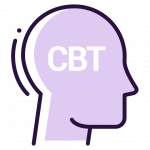EMDR THERAPY
Eye Movement Desensitization
& Reprocessing
What is EMDR?
EMDR, also known as Eye Movement Desensitization and Reprocessing, is a therapy technique that helps individuals process challenging memories and minimize their negative impact on daily life. Through the combination of cognitive therapy, bilateral stimulation and mindfulness practices, EMDR supports healing and aids in resolving traumatic experiences. It has proven effective in treating conditions such as post-traumatic stress disorder (PTSD), anxiety disorders, depression and symptoms associated with trauma.
How does EMDR work?
During an EMDR session, I may instruct you to follow my fingers with your eyes as they move from side to side, listen to tones played through headphones that alternate between the left and right ear or hold vibrating tactile devices that provide a pulsating sensation on both sides of the body. These bilateral stimulation techniques are used to stimulate the brain’s information processing mechanisms and promote the resolution of trauma.
What does EMDR treat?
Trauma and adverse life experiences can have a profound impact on mental health. EMDR has been extensively researched and proven effective in addressing various psychological concerns, including:

PTSD
EMDR has shown great success in treating PTSD resulting from trauma. By targeting distressing memories, it helps individuals process and integrate their experiences, leading to reduced PTSD symptoms.

Anxiety Disorders
EMDR provides benefits for anxiety disorders such as panic, social anxiety, and generalized anxiety. It helps alleviate distressing emotions, thoughts, and bodily sensations, empowering healthier coping mechanisms.

Depression
EMDR is effective in treating trauma-related depression. By reprocessing negative beliefs and emotions tied to past trauma, it offers relief from symptoms, restores hope, and enhances overall well-being.

Substance Abuse

Phobias & Fears

Distressing Memories & Events
What can you expect from EMDR therapy?
In EMDR therapy, I provide a safe and supportive environment where you can explore and process your traumatic experiences. I will guide you through the process, helping you identify and address the root causes of your distress. EMDR aims to alleviate the emotional distress associated with trauma and promote positive changes in your thoughts, feelings and behaviors.
Why choose EMDR?
If you’re ready to embark on a transformative journey towards healing, I am here to support you. Schedule a consultation and learn more about how EMDR therapy can help you overcome your challenges and achieve lasting change.
EMDR via Telehealth: Accessible and Convenient
Yes, EMDR therapy can be conducted through telehealth or online platforms, allowing individuals to receive treatment remotely. Telehealth has become increasingly popular and widely used, especially for mental health services, providing greater accessibility and convenience for clients.





